On the night of the 26th/27th May, 1943 RAF Sgt. Pilot G. N. Cockcroft from Bradford, West Yorkshire, then based at RAF Little Rissington, Gloucestershire, (No. 6 (P) AFU Pilots Advanced Flying Unit), found himself seconded to No. 77 Squadron 4 Group Bomber Commando, stationed at Elvington, near York, taking part in an air marking raid over Essen, Germany, which involved dropping incendiaries on the target by the lead Bombers to illuminate the target.
“The first wave had already bombed the general target area - now well alight. Two or three minutes before our final run in, at approximately 18, 700ft, we saw in front but slightly to port, at about the same height, a long cylindrical object, silver/gold in colour, very sharply defined, hanging in the sky at an angle of approximately 45 degrees, showing a number of evenly spaced portholes along its length.
The first person to sight the object was Sgt. Pilot Ray Smith, of the Royal Canadian Air Force:
“I think the first reaction of most of us was amazement because the object just had no right to be there. After a very short space of time, about 20-30 seconds, it suddenly began to move and, retaining its altitude, climbed rapidly until it vanished from sight. The speed it attained seemed to us completely incredible, moving at thousands of miles per hour. As it accelerated, the outline became more blurred and the shape foreshortened. The size is more difficult to judge but it was very large, certainly much bigger that our own aircraft, appearing at least as long as a ‘king sized cigarette,' or small cigar at arms length, we then completed out bomb run and returned to base. The intelligence officer debriefing us was given a description of the object but we were unable to judge what importance was attached to it and quite frankly it was just another unusual phenomenon, which since apparently harmless was of far less importance that other wartime hazards.”
Despite investigations made by the authorities on both sides no
satisfactory answer was ever found for the appearance of these
curious light flight phenomena, described as looking like flying
silver balls, discs, and Christmas trees, often seen pacing the
aircraft in precise formations.
(Source: Norman Oliver, BUFORA)
Reproduced from: Haunted Skies, Volume One, pp33-34
A Weird Phenomenon
Mr. W. Young had an uncanny experience when, going on duty at the Burra Electric Light company's work at 3 a.m. on Thursday morning last. He heard a noise like a breeze rising, it then developed into a loud rumble. About a chain in width he next saw what appeared like a ball of fire of a light green colour coming from, a westerly direction. As this strange misty formation passed over him he said it felt almost like a heat wave and emitted a sulphurous flinty odour. This strange phenomenon of nature, then passed over the slag heap travelling in a north-easterly direction. We understand on discussing this strange happening with individuals, Mr. Young has met one or two men who have witnessed at distinct periods a similar happening in the past. Possibly a meteorologist could explain.
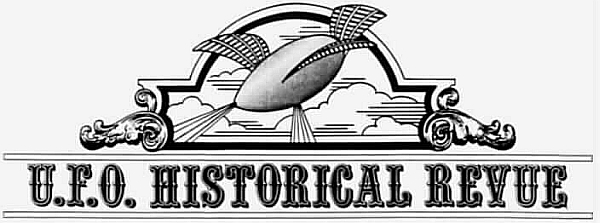
UFOs had become a distinct topic of discussion beginning in 1947. Prior to that time the phenomena didn't have a particular title, so that observations of peculiar aerial objects fell into no organized category, other than being interesting recollections with most often no permanent record kept. There are some exceptions to this (airships of the 1890s, Foo-fighters; etc.) but reports of UFO-type phenomena prior to 1947 are usually fragmentary, almost to the point of being uninvestigatable. Nevertheless, some of the observations still present a mystery, if only as a contribution to the cultural memory.
A former aircraft observer, who we will call Shirley, recently related her memory of a peculiar object seen around 1943 or a bit later. She was a volunteer aircraft spotter in north central Massachusetts, helping to fill in one of the air defense needs in the days of primitive radar. Manning a tall building or specially built tower, these volunteers would maintain contact with other similar posts along the U.S. coast, ready to relay information about unknown aircraft overflying American air space.
One day Shirley received a radio message from a coastal Maine post of a strange vehicle heading south. Soon enough, the object was visible from her location: a stubby fuselage with huge, oval wings on either side (see inset).
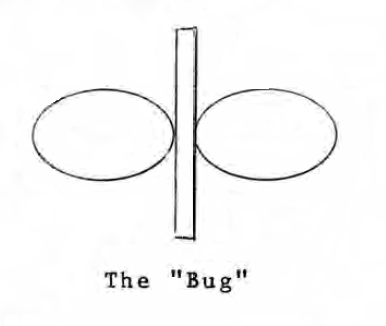
It continued heading south and was thought to have been spotted by an observer at a post near Boston before it vanished. Apparently, after discussions with other observers, it was not the first time that this object was seen. It was assumed that it was some sort of secret or experimental glider for testing the observer's visual acuity.
Upon contacting her area's filter center about the sighting, she was instructed to log any reports under the name that was given to it; the "Bug", because of its resemblance to one. Shirley thought the instruction to be peculiar because the observers customarily logged any aircraft sightings by number. The "Bug" became something of an inside joke to the observers due to its weird appearance and elusiveness, but she never discovered its true identity, if it had any.
Another Massachusetts report during the summer of 1944 or 45 occurred at Wollaston Beach, just south of Boston. Mrs. Margaret Fornaro reported that on two consecutive days at 2PM a group of nine saucer-shaped objects were seen flying over the beach in view of hundreds. Traveling in echelon formation and spaced evenly, the discs occassionally tilted from side to side independently of one another. They were highly reflective and sometimes showed a golden color when tilted a certain way. The tilting had a two to three second cycle and the entire formation was in view for one to two minutes.
Said to have been reported in the Boston press, UHR is checking this possibility as it would place press coverage of a classic flying disc sighting several years earlier than the first acknowledged disc report by Kenneth Arnold. There is, however, a possibility that the sighting occurred in the summer of 1947, as there were a number of beach reports of discs in the Boston area.
Summer 1942: At Great East Lake, near Sanbornville, New Hampshire, David Townsend was visiting a friend. One night he was out fishing on the lake with a local girl. While David was watching the water where the line trailed, the girl let out a scream.
He saw her staring at the moon, and as he glanced up he could see what looked like a heavy streak of lightning running around the edge of the moon's disc, about a third to a half of its circumference. The girl had seen more of the jagged track, encompassing about two-thirds of the circumference. The total time for the trip was several seconds.
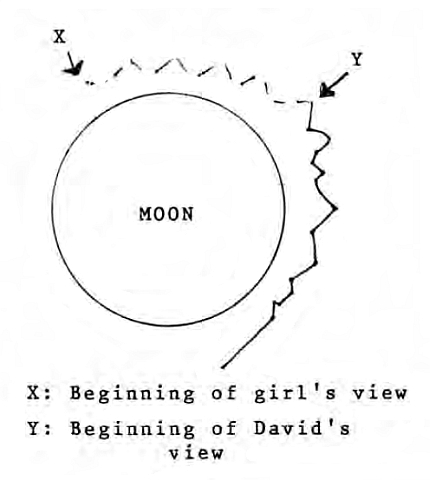
Was it lightning? The night was clear with the moon either full or within a couple of days of being so. No storms were in sight anywhere. The streak didn't appear instantaneously but developed a path over a short period of time. And what are the odds of clear air lightning following a path around two-thirds of the moon's circumference? Was it an aircraft? How does a plane leave a jagged, glowing path around the edge of the moon in just a couple of seconds?
West coast unknowns were noted as well. The most famous, the so-called "Battle of Los Angeles" of February 25, 1942, involved multiple objects being fired at by elements of Los Angeles's anti-aircraft gun emplacements in a frenzy of activity during the early morning hours. No bombs were dropped. No hits were scored on the unknowns and they were never identified. UHR can deal with this one in more detail later.
An aircraft spotter in Laguna, California was on duty in the early spring of 1943 at about 10AM. On a clear day the observer noted a large flashing, like a giant sparkler, discharging every 30 seconds high in the sky. A report was sent to Santa Ana Army Air Base and a P-38 was sent to investigate. The flashing continued until the P-38 closed in on its position when it ceased. AAF personnel were said to be quite upset by the event.
A rarity, a dated report, was filed by renowned aviation writer, Gerry Casey. On April 5, 1943 at 9:50AM, Casey was a primary instrument flight instructor supervising a student in a BT-13A trainer. Cruising near Long Beach, California with the student flying, Casey had glanced eastward and had noticed a peculiar flash in the sky. As he looked more carefully, he saw an aircraft in a moderate dive toward the trainer. Preparation for evasive action was made ready in case it was needed as the craft continued to approach, and then pass on the trainer's left side.
This "plane" was quite odd. It was radiant orange in color, with no openings or glass visible. There was no propeller or propulsion of any kind visible. It was elliptical, with a rounded hump on top and a smaller hump underneath. Size was difficult to determine without knowing the distance. It was unlike anything ever seen before.

The object maintained a precise formation with the trainer, showing something of a wobble or oscillation while in place. Casey thought of photographing it with a camera available in the plane but, thinking that the object was a secret aircraft from Lockheed (about which he had heard rumors), he decided against it, fearing wartime penalties for photographing secret test aircraft.
Suddenly, with the rear portion of the object moving slightly, it shot away, disappearing in a climbing turn toward the ocean in two seconds. It turned from orange to white as it accelerated. Total duration of the sighting was 90 seconds.
By today's standards of UFO research, this report would probably draw a deep yawn from the majority of those following this topic. The pilot and student weren't abducted and dissected. Their memories weren't tampered with. They weren't visited by "men in black." And they never toured talk shows or ended up in tabloids. The instructor was simply recalling a detailed odd event of the distant past that was not resplendent with Hollywood-style glitter or a scripted story line. It is merely one of those strange kinds of little puzzles that constituted the 5% or so of what the Air Force could not identify — the technically detailed report with credible witnesses that present an interpretive challenge to intelligent people. Unfortunately this has become archaeic in today's showbiz world, belonging only in an archaeic publication like this!
Activity continued in California in 1943. In Escondido one day in November around 1030PM, on a dark, moonless night, the Sledge family, husband, wife and son, were listening to the radio when Mrs. Sledge stepped outside for some air. She noticed an object hovering 15 feet above the roof of her house, shaped like a disc with a dome, some 12 feet in diameter. The dome had square windows all around, about 30 inches square each. Behind two of them she could see silhouetted shapes like men. The dome inside appeared to be like shiny chrome.
Mrs. Sledge ran into the house for her husband, thinking that an aircraft was in trouble. Both husband and son had the object in view but could not identify it. A quiet humming, like a spinning top could be heard as it hovered.
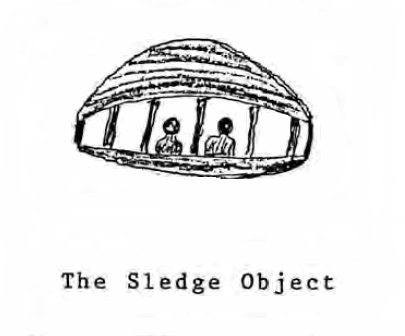
As Mrs. Sledge flashed a flashlight on the ground, believing that the object wanted to land, it blinked out its lights and disappeared. The family kept silent about it until many years later.
From an aircraft spotter in a post on top of the Los Angeles Coliseum in the summer of either 1942 or 43, observer Marie Hicks saw a golden-colored object similar in size to a large bomber at a great distance, hovering in the sky. Hicks was struck by the hovering aspect as the aircraft showed no movement. The morning sun had already risen, ruling out stars or planets. A balloon or aircraft moving directly away from the viewer? Perhaps.
1944 produced a few more west coast incidents. J.S. Taylor of Los Angeles recalled a sighting while working at a manufacturing plant on Slauson Ave. One night at 1130PM, he saw an orange-reddish light come down from the sky and hover 100 yards above the road. When Taylor approached for a better view, the light moved upward and away. Upon his going back to the plant, the light returned to its original position and remained for 5 more minutes after which it disappeared. It was seen by Taylor one other time but at a much higher altitude.
In a report sent to a NICAP subcommittee in Seattle in 1961, the following is described:
In the latter part of December 1944 and January and February 1945, radar operators at the Naval Air Station, Pasco, Washington, reported unusual blips on their radar screens. These blips appeared out of nowhere and proceeded from Northwest of the Air Station to the Southeast and consequently off of the radar screens. A fighter pilot was made available with an armed F6F fighter and given orders to shoot down anything that appeared to be hostile. He was vectored out on two occassions that this writer remembers, but, in each instance, made no contact. The blip always acted much like a Piper Cub aircraft and at about the same speed. The writer was vectored out one afternoon in an SNJ aircraft to make contact with one of these blips. This particular one appeared to be very high according to the radar operators. Nothing was sighted but the operators reported two blips on the screen. The writer is convinced that there was something there, but, the mystery as to what it was will apparently never be answered."
U.S.N.R.
Radar angels, i.e. false radar returns, were quite common in the early days of radar and can certainly account for reports like this, but with regard to unidentified flying objects, it is unusual to have this kind of detail to make such determinations decades after the fact.
A strange circular object, brilliant green in color, was seen from Vallejo, California during the summer of 1944 on a Friday afternoon. The object followed an arc toward distant hills, after which it followed the contour of the hills in straight, horizontal paths, with vertical steps corresponding to the need to elevate position to maintain contour. The object then arced again toward the horizon and disappeared. Duration: 3 to 5 seconds.
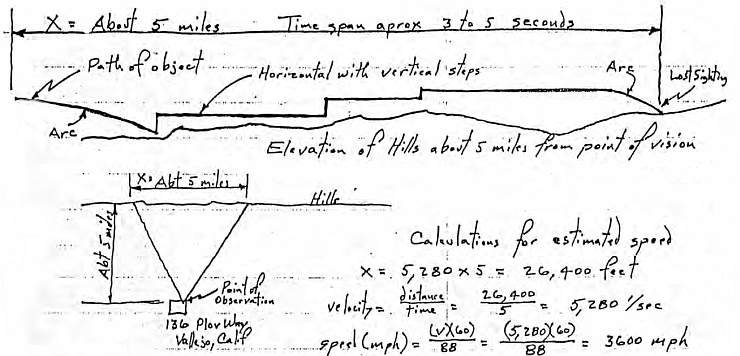
This article is designed solely to describe what kind of unknown aerial phenomena activity existed along the coastal U.S. during World War 2, a notoriously poorly-described time in the annals of UFO research. Ultimately, many might be explainable with better data, but it is more likely that they will remain odd tales from an increasingly distant past.
UHR will have much more on the World War 2 era. There are still other domestic accounts as well as a large amount of new information on the "Foo-fighter" phenomena abroad, many of these gleaned from government bombing mission reports and Air Force histories unearthed recently through the efforts of Project 1947 researchers.
Unless otherwise stated, reports described in UHR come from case files created from letters by participants, or organizational report forms signed by witnesses. Occassionally, the witnesses desire anonymity, so if names are missing, this is why.
This article reproduced with permission of the author. Additional issues of UFO Historical Revue can be read at The Barry Greenwood UFO Archive.
More information about aircraft observers — members of the Aircraft Warning Service (AWS) — can be read here.
Just Cause -page 4, June, 1992:
What were Foo-Fighters? Hallucinations? Alien ships? Natural phenomena? The official records do not suggest what they were except that they were no threat to the aircraft of either side.
A previously unknown account has surfaced. Connecticut resident Louis Kiss has advised CAUS of his own experience with Foo-Fighters. Kiss, then a Staff Sergeant, was a tail gunner on the "Phyllis Marie," a B-17 bomber of the 390th Bombardment Group, 3rd Division of the 8th Air Force.
In late 1943, while on a daylight mission over central Germany, Kiss observed an odd-looking sphere approach the B-17 from behind and below. He said it was about the size of a basketball and of a shimmery gold color. The ball reached the aircraft and hovered Just above one wing after slowly moving from the rear. Soon it passed over the top of the aircraft to the other wing where it again hovered. Sgt. Kiss was tempted to shoot at it with his machine gun but, considering the proximity of the ball to the B-17's gas tank, he thought better of it.
As Kiss watched, the ball moved toward the rear again, became caught in the B-17's backwash and rapidly disappeared into the remainder of the B-17 formation. He never knew if anyone else in the group had seen the ball but he did officially report it to his intelligence officer. Curiously, Kiss had never heard of Foo-Fighters until we had mentioned them to him. His report does parallel several sources. The War Diary of the 415th for December 23 told of Foo-Fighters climbing from below, much the same as Kiss described.
More can be read about colorful history of the Phyllis Marie at the 390th Bomb Group website:
In 1943 I was an Instrument Flying Instructor assigned to the 6th Ferrying Group of the Air Transport Command and based at Long Beach, California. My daily routine consisted of flying four, one hour instructional periods in the morning with a different student for each hour. On one flight while proceeding on the southwest leg of the Long Beach radio range at 5000 feet altitude at the normal cruising airspeed of a BT-13A type trainer, my student and I witnessed an object at this point which to this date defies logical explanation.
This object appeared from the northeast on a level flight path and turned while decelerating from a great speed to fly parallel to us for approximately 30 seconds before it disappeared from view at a slight climbing attitude (5 degrees) bearing to the right across out ship's nose and at speed which I can now estimate to be between 2000 to 5000 miles per hour.
So many years have since passed that it is difficult to reconstruct the appearance of the object but a few prominent facts are still clear and vivid in my mind. They are:
1) This incident occurred above a fog overcast with clear and unlimited sky condition above.
2) The object was an International Orange in color, had an elliptical or rounded forward structure, was proportioned in a manner as a conventional aircraft's fuselage.
3) The rear of the object either had no significance or I am unable to remember its profile.
4) No propellers or jet orifice were visible; nor was any flame, smoke or vapor trailed.
5) It decelerated in an unstable manner. (IE) Wobbling outward from its banked attitude while turning and dipping longtitudinally up to ten degrees from its flight path.
6) It flew exactly abeam at our altitude and while in this position exhibited no other motion than the identical forward speed of our ship.
7) Its departure from the area also appeared unstable at the start of its acceleration. It seemed to lurch forward with the rearward portion wobbling until its direction was established.
8) From its position abeam to ten degrees to the right of our nose and five degrees high until out of sight took approximately one and one half second.
A series of unusual events contributed to the fact that this object made no striking impression on my student and me. There had been a rumor at this time that Lockheed Aircraft Company were building a jet aircraft and we thought we had witnessed the flight of it. I learned much later that the first flight of the Lockheed P-80 did not take place until over a year from this period of time.
Furthermore, I had a camera in the aircraft at this time and although it was hanging on the 'oil dilution' control nob and ready to use, I did not use it for fear of photographing a highly secret aircraft.
I can (remember) telling the student through the intercom: "Come out from under the hood. Lockheed's jet is flying formation with us."
The student pushed back the hood and both of us witnessed the object flying alongside and its flight out of sight. Then the student went back under the hood and the episode was ended. In retrospect, I believe the fact that neither of us at that time attached anything unusual about it must imply that it resembled something which would have encompassed known aerodynamic outlines. Until I first witnessed an early flight of the P-80, I was under this impression. Immediately upon seeing the relative slowness of the P-80 and its easily identifiable outlines, I realized we had witnessed some inexplicable object...."
The writer did not remember the name of the student, but he enclosed a drawing of the object and a list of students who could have been the other witness. The 1952 UFO flap was just starting, but hundreds of letter poured into Project Blue Book. They had no time to even acknowledge the letter let alone investigate what they considered an old case. So they simply filed the letter along with hundreds of others they received on many different subjects in a "catch all" file. They did not include this report as a case file nor did they count it in the Blue Book statistics. - J.L.A.
Shortly after the above account appeared on the Project 1947 site, I was contacted by a friend of the letter writer, Gerry A Casey, who had not been identified as the author. He asked if I would like to talk to Mr. Casey who kindly agreed to a telephone interview. He also supplied items from his flight log book which established the date and time of the incident: about 9:50 a. m., on April 5.
Mr Casey's letter to ATIC did not result in any follow up investigation. (Understandable as it would have come into ATIC just at the beginning of the 1952 flap.)
Casey had thought his "UFO" was a technologically advanced experimental craft until after the war when he saw a P-80 jet and realized it had far lower performance than what he and the student pilot had witnessed. (Two other similar observations in which the witnesses thought they had misidentified common objects only to reconsider in view of what they had learned later come to mind: Winter 1944-45, Naval Air Technical Training Center, South Base, Oklahoma, the observer Mr. Vern Seifert thought he might have seen a radar target, but later understood his sighting of a "spinning, shimmering bright sphere" could not have been such a target. Approximately 26-31 January, 1945, between the Solomon Islands and New Caledonia in the Pacific, observer Mr. Louis Gracie thought he had seen a large sea turtle pass beneath his ship, but later learned that sea turtles could not grow to such a large size.)
After Mr. Casey sent his account to the Air Force he met the student pilot who was in the plane with him and who had also observed the object. When the subject was broached with him, he declined to talk about it and told Casey he never wanted to discuss it again.
Over the years Casey has told his story to other pilots. From over 90 percent he got about the same answer, "Change your brand of whiskey." The others had seen something themselves which they could not explain and were less judgmental. He had one other UFO observation in 1954, when a multi-engine prototype bomber which later lead to the B-52 was flown by Boeing over the area. As he watched he noticed a spindle-shaped object behind the aircraft. He watched the object intersect one of the contrails and noted that the object appeared to "burn away" the area of the contrail it had passed through. (This is similar to other reports termed "cloud cutters" in which cloud, fog or vapor trails seem to be burned away near the object.)
He had written of his original sighting in a small west coast aviation publication some years earlier.
He did not report his observation at the time as he had been told he might encounter experimental craft during his flights. He thought that is what had happened, and there was no reason to report it or photograph it, even though he carried a camera on the flights.
Mr. Casey was still a pilot into the 1990s.
Observer: C. L. Reifenhler
During the voyage, a multicolored object about the size of a basketball appeared and the ship changed course to parallel the course of the object. The object was in view for about 20 minutes, moved slowly across the water at a height of 5 feet, and finally disappeared. It looked like a glass ball and appeared to have a membrane enclosing it. Its motion was from the NW to SE and it was seen sometime between 3:00 and 5:00 in the afternoon sometime in September 1943. The color was at times orange and yellow, sometimes green, blue and red. The sky was overcast and the object was on the starboard side of the ship as it moved toward the NW. The ship's crew, consisting of about 20 men, saw the event and conclude it might be a “fireball.”
Source: Personal communication from James Seal to William R. Corliss,
June 25, 1986.
Corliss, William R., Remarkable Luminous Phenomena in Nature, The
Sourcebook Project, Glen Arm, MD, 2001, pages GLD 7-8
Under this heading there occur from time to time reports of weird and wonderful apparitions seen during our (and the American) attacks on Germany. We have asked our local Inner Circle bloke to comment on the latest species of wizardry. Here is his story....believe it or not.
"On the 11th December the Yanks paid one of their daylight visits to Emlen. [Emden] Visibility was good and the weather clear.
"An unidentified object was seen in the target area. It was about the size of a Thunderbolt and passed 50/75 yards beneath the formation. It flew STRAIGHT and LEVEL. (No chaps it was not a Lanc gone mad..) at a terrific speed, leaving a streak like a vapour trail which was all white and which remained visible for a long time. The object passed so quickly that the observer could not determine it more accurately..."
Suggestions will be welcome...serious ones...as to what this Loch Ness Monster of Emlen might have been.
A couple of paragraphs later, after some general comments about the raid, the article continues:
"In another attack...this time on Bremen...there were many reports of "silver and red discs above the formations". These have been seen before but up to now no-one has been able to decide their purpose. Suggestions please."
Source: Andy Robert's research at PRO - UK Public Record Office